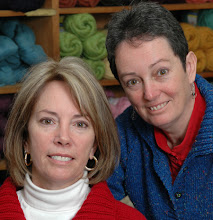
I got the yoke done on my sample and had just worked the Divide Round when I had to pack it in last night. Once your head hits your knitting 3 times it's time to go to bed. Or is that when your book hits your face ... either way I'm picking it up today and should get a fair ways along. This is the Tiny Top Down www.cabinfever.ca/P608.html pattern and yes the new Cotton Tweed colour is that orange. We have 5 new colours and now for the skill testing question 'what are they called?' - Orange, rhubarb (pinky red), flannel (grey), birch (mid brown), & emerald green. Got it in one.
One of my favourite increase is still the backward loop. I wrap the yarn around my finger one way for the first increase, knit one stitch, and wrap the yarn the opposite way for the second increase. On the next round I knit into the back or front of the loop whichever will twist the yarn a second time to tighten up the loop. Can you see it there? There is only one stitch between the 2 increases but the legs of the backward loops make the raglan line wider and what I especially love is that it doesn't interrupt the flow of my knitting too much.
Your choice of increase on a pullover is especially important since you work one round with increases followed by a second round of plain knitting. If you are part way through a round and the phone rings, you come back to pick up your knitting and ... oh, no, which round am I on, the increase or knit round? Your increase should show you. With the backward loop either there is a loop on the needle which you will knit (knit round), or there in no loop which means you need to put a loop on (increase round). It saves confusion and that little line of ticks on the side of your pattern as you try to keep track.
I'm heading for my chair and to listen to what Richard Jury is going to do next because he is once again in a muddle (Martha Grimes audio book). First to boil the kettle.
-Deb




No comments:
Post a Comment
If you would like a reply to your comment, please include your email address.